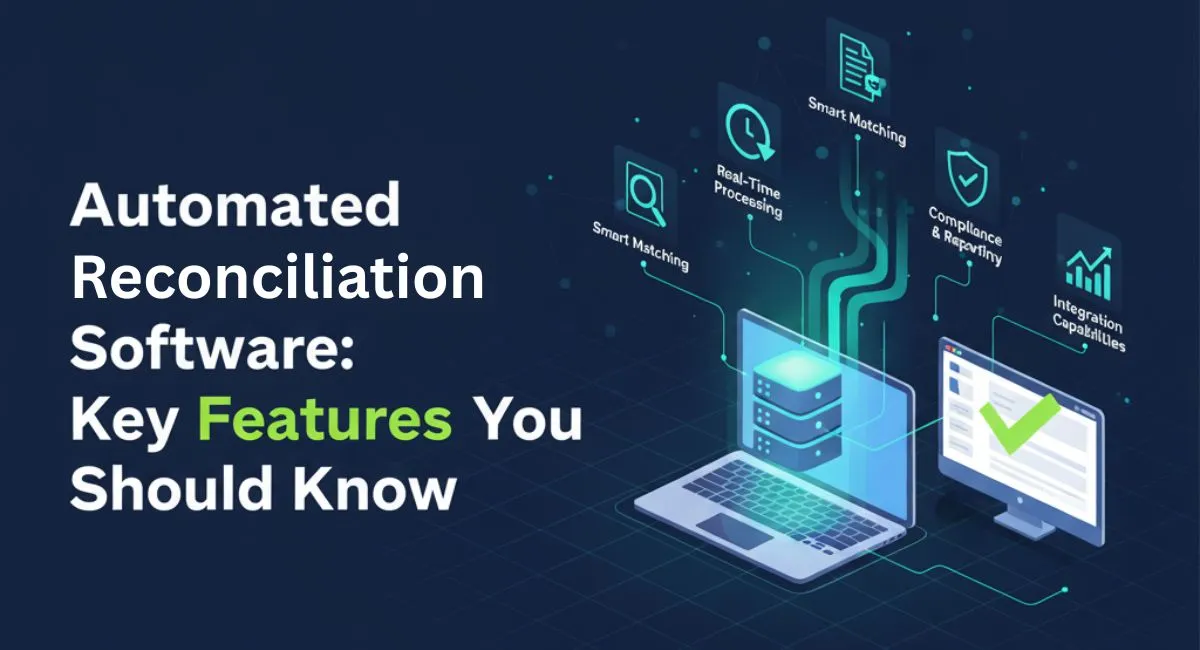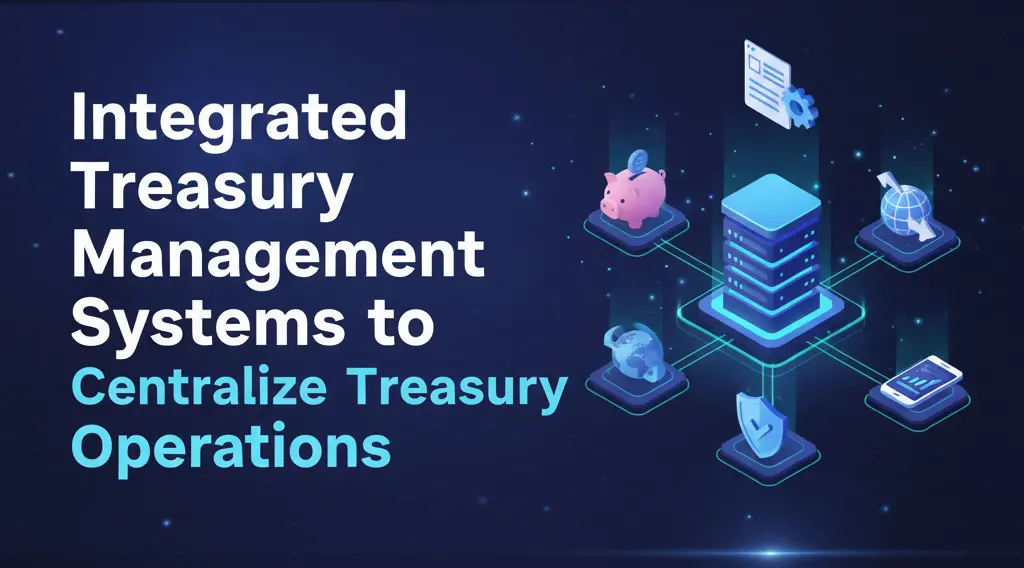Automated Reconciliation Software: Key Features You Should Know
In today’s fast-moving financial world, accuracy and efficiency are everything. For finance teams handling large volumes of transactions daily, manual reconciliation is no longer practical. It’s time-consuming, error-prone, and limits the team’s ability to focus on strategic work. This is where automated reconciliation software comes into play.

Automated reconciliation systems are designed to make financial data matching faster, more accurate, and fully auditable. But with so many tools on the market, how do you know which features matter most? In this blog, we’ll break down the key features you should know about automated reconciliation software, why they’re essential, and how they can transform your financial operations.
What Is Automated Reconciliation Software?
Automated reconciliation software is a digital tool that helps businesses match financial transactions automatically between internal records and external data sources like bank statements, payment gateways, ERP systems, and accounting platforms.
Instead of manually comparing spreadsheets, the software uses algorithms to detect matching entries, highlight discrepancies, and ensure all financial data is accurate and up to date.
It’s widely used in industries like banking, e-commerce, fintech, retail, and gaming, where thousands of transactions occur daily.
By eliminating repetitive manual work, automated reconciliation tools give finance teams more time for analysis and decision-making.
Why Businesses Are Moving Toward Automation
In traditional reconciliation, finance teams spend hours reviewing data line by line, identifying mismatches, and adjusting records manually.
This manual process often leads to delays, human errors, and compliance risks. Moreover, as businesses scale, the number of daily transactions grows, making manual reconciliation nearly impossible to sustain.
Automation solves these challenges by:
- Reducing time spent on repetitive matching tasks
- Eliminating errors caused by manual entry
- Ensuring real-time visibility of financial data
- Improving compliance and audit readiness
- Allowing finance professionals to focus on analysis instead of manual work
In short, automation helps organizations move from a reactive to a proactive financial management approach.
Key Features of Automated Reconciliation Software
Let’s now explore the most important features that make reconciliation automation powerful, efficient, and reliable.
1. Data Integration with Multiple Sources
A great reconciliation system seamlessly integrates with multiple data sources such as:
- ERP systems (like SAP, Oracle, or Tally)
- Bank accounts and statements
- Payment gateways (such as Stripe, Razorpay, or PayPal)
- Accounting tools (like Xero or QuickBooks)
- Internal ledgers and invoices
This integration ensures all your data flows into one centralized dashboard. No more jumping between systems or manually importing files.
For example, Kosh.ai, a modern reconciliation automation tool, allows easy connection with both internal and external systems for real-time data syncing. This saves hours of effort and reduces data discrepancies.
2. Automated Transaction Matching
One of the biggest time-savers is automated matching. The software intelligently compares transactions from different sources using defined rules and algorithms.
It matches entries based on parameters like amount, date, reference number, or transaction ID. Advanced tools even use AI and machine learning to detect fuzzy matches, meaning they can spot near matches even if data isn’t identical.
For instance, if there’s a typo or missing digit in a transaction ID, the system can still recognize it as a likely match.
This feature drastically reduces manual intervention and ensures that every transaction is accounted for accurately.
3. Exception Management and Alerts
Even with automation, discrepancies are bound to happen. A good system should not only identify mismatches but also highlight and categorize exceptions for quick resolution.
Exception management features include:
- Automatic flagging of unmatched transactions
- Categorizing issues (missing data, incorrect amounts, duplicates, etc.)
- Real-time alerts for critical mismatches
- Audit trails for tracking resolution history
With this feature, finance teams can focus only on exceptions that need human review instead of spending hours verifying all transactions.
4. Real-Time Dashboards and Reporting
Automated reconciliation tools come with visual dashboards that give instant insight into your financial status.
Key metrics such as reconciled items, pending mismatches, and cash flow summaries are displayed in real-time.
Reports can also be customized and exported to share with auditors, CFOs, or management.
This real-time visibility helps in:
- Faster month-end closing
- Better cash flow management
- Early identification of anomalies
- Improved financial control and transparency
Some platforms, like Kosh.ai, provide AI-powered analytics to highlight trends and patterns that can help forecast potential financial risks.
5. AI and Machine Learning Capabilities
Modern reconciliation software uses AI (Artificial Intelligence) and machine learning to continuously improve accuracy.
The system learns from historical data and user corrections to predict future matches more effectively.
Benefits of AI in reconciliation include:
- Smart rule generation for complex scenarios
- Reduced manual intervention over time
- Identification of unusual transactions or fraud patterns
- Faster resolution of exceptions
AI-driven automation ensures that the more you use the system, the smarter and more efficient it becomes.
6. Audit Trail and Compliance Features
Every financial system must comply with regulatory standards and internal audit requirements. Automated reconciliation software simplifies this by maintaining a complete audit trail of all reconciliations performed.
Each step, from data import to final reconciliation, is logged with user details and timestamps.
This transparency makes audits faster and more accurate. Moreover, compliance with standards like IFRS, SOX, and GAAP becomes easier since all data is traceable and verifiable.
7. Security and Data Encryption
Financial data is highly sensitive, and security should be a top priority.
A robust reconciliation system ensures:
- End-to-end encryption for all data transfers
- Role-based access control to restrict sensitive information
- Secure cloud infrastructure compliant with ISO or SOC standards
- Multi-factor authentication for user verification
By using secure reconciliation tools, businesses can protect financial data and maintain customer trust.
8. Scalability and Flexibility
As your business grows, so does your transaction volume. Manual systems often struggle to scale.
Automated reconciliation software should easily handle increasing transaction volumes without affecting performance.
It should also be flexible enough to adapt to different reconciliation types, such as:
- Bank reconciliation
- Vendor reconciliation
- Customer account reconciliation
- Intercompany reconciliation
- Payment gateway reconciliation
This scalability ensures long-term usability and cost efficiency.
9. Rule-Based Automation
Every organization has unique financial processes. A rule-based system allows users to define custom matching rules that align with their accounting practices.
For example:
- Match by invoice number first, then by amount
- Allow tolerance of small rounding errors
- Ignore certain fields during matching
Such configurable rules help automate even complex reconciliation scenarios. It ensures the software works the way your finance team operates, not the other way around.
10. Cloud-Based Access and Collaboration
Modern reconciliation systems are cloud-based, allowing teams to collaborate from anywhere.
Multiple users can view, verify, and approve reconciliations simultaneously. Updates are reflected in real time.
This remote access also means automatic backups, minimal IT maintenance, and easy software updates.
Cloud-based solutions are ideal for distributed or hybrid finance teams that need to stay connected and productive.
11. Automated Adjustments and Journal Entries
After reconciliation, unmatched transactions often need accounting adjustments. With advanced automation, the software can automatically generate journal entries or suggest them for approval.
This eliminates repetitive data entry tasks and speeds up month-end or quarter-end closing cycles.
Integration with accounting systems ensures that approved adjustments are instantly reflected in financial statements.
12. Customizable Reports and Insights
Another key feature is report customization. Finance teams can design reports according to their needs, such as:
- Reconciled vs. unreconciled items
- Daily or monthly reconciliation summaries
- Exception reports by category or priority
These insights help track performance metrics like reconciliation completion rates, exception aging, and transaction patterns.
Custom reporting ensures better decision-making and audit readiness.
13. Workflow Automation and Approvals
Many businesses have multi-step approval processes for reconciliation.
Workflow automation allows users to:
- Assign tasks to team members
- Set up approval hierarchies
- Notify reviewers automatically
- Track status of pending reconciliations
This structured approach ensures accountability and reduces delays in the reconciliation cycle.
14. Integration with AI-Powered Finance Platforms
Today, reconciliation software doesn’t operate in isolation. It’s often part of a larger finance automation ecosystem.
Integrating it with AI-powered tools like Kosh.ai allows organizations to automate not only reconciliation but also related processes like cash flow forecasting, accounts payable, and reporting.
Such holistic integration helps achieve full financial visibility and control across all operations.
Benefits of Automated Reconciliation Software
Once you implement automated reconciliation software, the benefits are clear and measurable:
- Time Efficiency: Reduce reconciliation time from hours to minutes.
- Improved Accuracy: Minimize human errors and data inconsistencies.
- Enhanced Compliance: Maintain audit-ready documentation.
- Real-Time Visibility: Always know your financial position.
- Cost Savings: Lower labor costs and eliminate manual errors.
- Scalability: Easily handle increasing transaction volumes.
Businesses using automation have reported up to 80% faster reconciliation cycles and 95% reduction in errors.
Also Read: Automated Reconciliation Software for Faster Month-End Closing
How to Choose the Right Reconciliation Software
When selecting the best reconciliation solution for your business, consider these factors:
- Integration Capabilities – Does it connect with your ERP, bank, and payment systems?
- Ease of Use – Is the interface simple and intuitive for your finance team?
- Customization Options – Can you set your own rules and workflows?
- Security Standards – Does it meet global compliance and encryption norms?
- Customer Support – Is the vendor available for quick help when needed?
- Scalability – Can it grow with your business?
Look for a solution like Kosh.ai that offers all these capabilities with AI-driven matching, advanced analytics, and seamless integration.
The Future of Reconciliation Is Fully Automated
As financial technology evolves, automation is no longer optional. Businesses that still rely on manual reconciliation face higher costs, slower closings, and greater compliance risks.
The future lies in intelligent, data-driven systems that can reconcile in seconds, predict discrepancies, and keep your books audit-ready 24/7.
Tools like Kosh.ai are leading this transformation, helping businesses streamline reconciliation and gain total financial control.
Also Read: How to Set Up an Automated Reconciliation System for Finance Teams
FAQs
1. What is automated reconciliation software?
It is a digital solution that automatically matches financial transactions between systems like bank accounts, ERPs, and ledgers to ensure accuracy and consistency.
2. How does automated reconciliation improve accuracy?
It eliminates manual errors by using rule-based matching and AI-driven algorithms to detect and reconcile data precisely.
3. Can small businesses benefit from reconciliation automation?
Yes, small and medium businesses benefit greatly by saving time, reducing manual work, and ensuring accurate financial reports.
4. Is automated reconciliation software secure?
Yes, modern solutions use encryption, role-based access, and compliance protocols to safeguard all financial data.
5. How does Kosh.ai help with reconciliation?
Kosh.ai automates reconciliation across multiple sources, matches transactions intelligently, and provides real-time analytics and dashboards for complete financial control.
6. Can reconciliation software integrate with existing accounting tools?
Absolutely. Most systems integrate easily with popular accounting tools, ERPs, and payment gateways for seamless data flow.
Contact us now


.webp)







